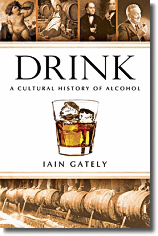 Iain Gately's books include Tobacco: A Cultural History of How an Exotic Plant Seduced Civilization. Raised in Hong Kong, he studied law at Cambridge University and worked in the financial markets of London.
Iain Gately's books include Tobacco: A Cultural History of How an Exotic Plant Seduced Civilization. Raised in Hong Kong, he studied law at Cambridge University and worked in the financial markets of London.He applied the “Page 99 Test” to his new book, Drink: A Cultural History of Alcohol, and reported that "by happy co-incidence p 99 of Drink is indicative of the style and content of the rest of the book."
The text for p 99 is set out below. The page begins with an illustration from the codex Mendoza with the caption "An Aztec Matron enjoys the milk of old age."Read more about Drink at the publisher's website.
quantities of pulque. The results, according to a Spanish source, were ugly: “Once drunk, they would quarrel among themselves, they cuffed one another and fell on the fl oor on top of each other, or else they would go embracing each other.”
In addition to the aforementioned exceptions, some people were cursed by the stars to drink. Rabbit served as an astrological marker—it was one of the signs of the Aztec zodiac, and anyone born on the day of Umetochtli—2- Rabbit—was destined to become a drunk, who “would not look for anything else in life save alcohol . . . and only drink it . . . in order to get intoxicated . . . even before breakfast”. Two- Rabbits were easy to spot, as they were notoriously unkempt: “They totter along, falling down and getting full of dust, and red in the face. . . . They do not care, although they may be covered in bruises and wounds from falls, provided they can get drunk, nothing else matters.” Interestingly, the Aztec legal process was unusually sympathetic toward them. Their drunkenness was a valid alibi for any crime. “He has become his rabbit” would be the judgment, and punishment would be left to fate. The defense of possession by one’s rabbit was proof against every charge, though at the price of stigma—people born on luckier days had nothing but “loathing and hatred” for 2- Rabbits.
The Spanish did their best to exterminate Aztec and other New World religious practices and to replace them with Christianity. All the traditional drinking occasions were prohibited, as were the intricate laws governing who might drink and when. This cultural apocalypse resulted in an increase in tippling among their new subjects, to whom it became a secular, as opposed to ritual, pastime.
--Marshal Zeringue



